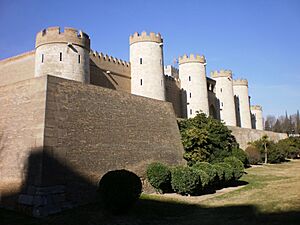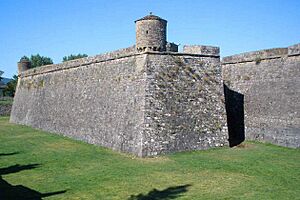Tibúrcio Spannocchi facts for kids
Quick facts for kids
Tiburzio Spannocchi
|
|
|---|---|
| Born | 1541 |
| Died | 1609 |
| Nationality | Siennese, Spanish |
| Occupation | Military Engineer |
| Known for | Chief engineer to Philip III of Spain |
Tiburzio Spannocchi (born 1541, died 1609) was a very important military engineer. He worked for the kings of Spain, Philip II of Spain and later Philip III of Spain. In 1601, he became the "Chief Engineer" for the king. You might also see his name spelled as Spanucchi, Spanochi, Spanoqui, or Hispanochi.
Contents
Who Was Tiburzio Spannocchi?
Tiburzio Spannocchi was an engineer from Siena, a city in Italy. He was born in 1541. He came from a noble family in Tuscany, a region in Italy.
Before working for Spain, he served the Papal States. This was a group of territories in Italy ruled by the Pope. He worked in their navy, under a leader named Marcantonio Colonna. In 1575, he was sent to Sicily as a Viceroy, which means he was like a governor. Around 1580, Spannocchi started working for the King of Spain.
Spannocchi's Engineering Projects
Spannocchi worked on many important building projects for the Spanish kings. Most of his work involved designing and building forts and other military structures.
Controlling the Strait of Magellan
One of Spannocchi's early projects was to control the Strait of Magellan. This is a sea passage at the southern tip of South America. The idea was to build two strong forts on opposite sides of a narrow part of the strait. These forts would be at Punta Anegada and Punta Delgada.
The plan was to make it impossible for ships to pass through. A large chain could even be stretched between the two forts. Experts thought his designs for these forts were very good. However, the project was stopped. People realized that many ships could simply sail around Cape Horn instead of using the strait.
Forts in the Americas
Spannocchi also worked in the Americas. He was in Havana, Cuba, between 1586 and 1587. He might have also worked in San Juan, Puerto Rico, and Cartagena, Colombia.
In 1588, he approved plans for two important forts in Havana, Cuba: El Morro and La Punta. He was the senior engineer for King Philip II at that time.
Work in Gibraltar and Spain
King Philip II also asked another engineer, Giovan Giacomo Paleari Fratino, to make the Fortifications of Gibraltar stronger. Fratino wanted to tear down a wall that another engineer, Giovanni Battista Calvi, had started. But Spannocchi disagreed and insisted that work continue on the zigzag wall. This wall was finished in 1599 and is now part of the Charles V Wall.
Spannocchi also worked on the Aljafería citadel in Zaragoza, Spain. King Philip II himself had drawn the first plans for this project. The king wanted Spannocchi to fortify the palace and turn it into a strong military base.
Spannocchi completed this work in 1593. He built the fortress using bricks and mortar, with strong cornerstones. He also added a moat around it. The two main entrances were beautifully decorated. After these changes, the Aljafería was used by the military until the mid-1900s.
Later, Spannocchi focused on mapping areas in the Pyrenees mountains. This region forms the border between Spain and France. There was a lot of tension between the two countries at the time.
Under his guidance, the citadel of Jaca was built in the shape of a pentagon. In 1598, he suggested building a small fort to protect the entrance to the port of Pasaia. However, planning for this fort didn't start until 1620.
At the beginning of the 1600s, Spannocchi and another engineer, Jerónimo de Soto, helped build the palace of La Ventosilla in Burgos. They added things like running water to make it more comfortable.
Forts in Brazil
Spannocchi designed two important forts in Brazil. One was the nine-sided Fortaleza da Lage de São Francisco, which protected Recife from the sea. The other was the Forte do Mar de São Marcelo, which defended Salvador da Bahia. The plans for these two forts were sent to Brazil in May 1606.
Tiburzio Spannocchi died in 1609.
Spannocchi's Influence and Legacy
Spannocchi had a lasting impact on military engineering. In 1582, he and Juan de Herrera started the Department of Mathematical Military Architecture. This was a very important school. It trained many military engineers and architects, with the support of King Philip II.
Jerónimo de Soto was one of Spannocchi's students. Another important student was Cristóbal de Rojas. Rojas worked as Spannocchi's assistant and became very interested in military architecture. He completed major projects in Spain and North Africa.
Rojas also wrote a book called Teórica y práctica de la fortificación ("Theory and practice of fortification"). This book was published in 1598. It was the first book about the science of fortification published in Spain. The book was mostly a collection of lessons from the Madrid Academy of Mathematics. It showed how much the Italian School's ideas about polygonal and radio-concentric (circle-based) fort designs influenced them.
See also
 In Spanish: Tiburzio Spannocchi para niños
In Spanish: Tiburzio Spannocchi para niños




